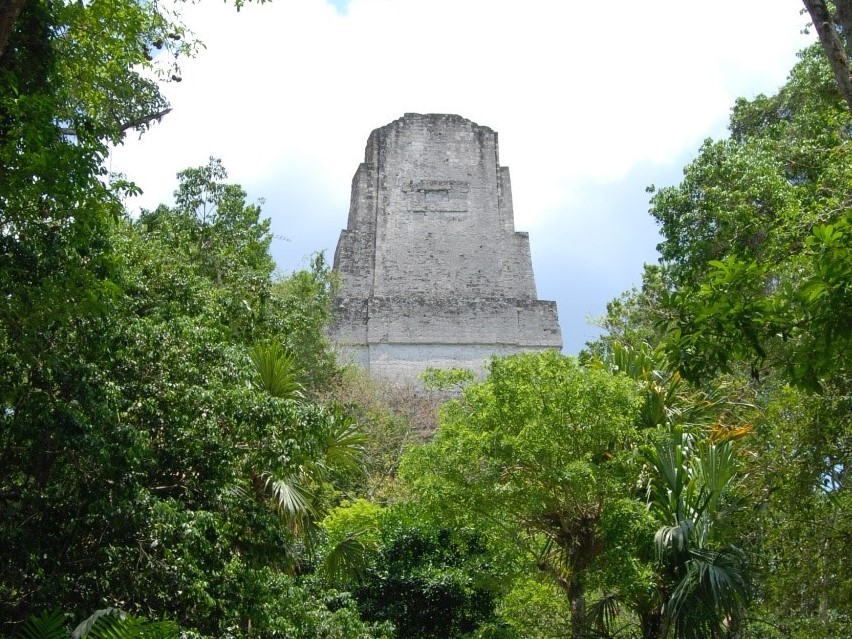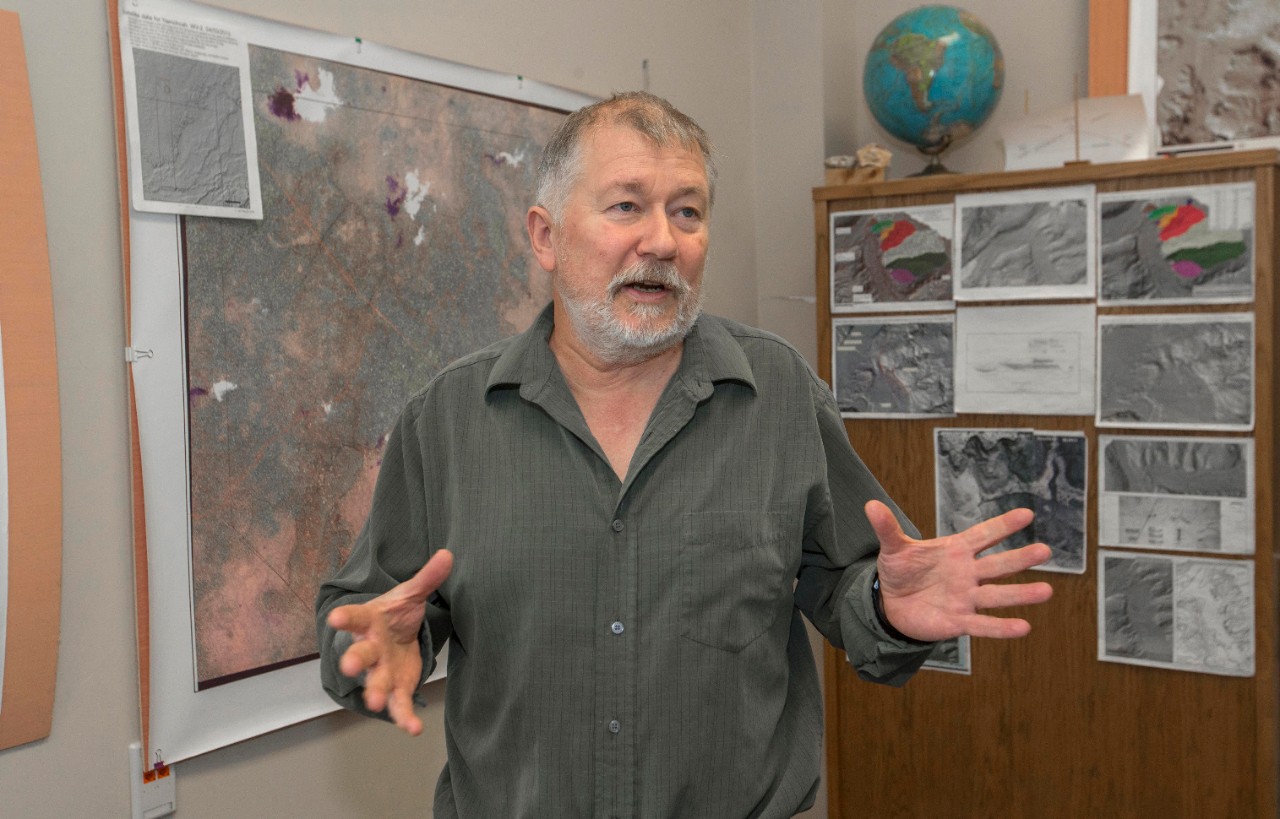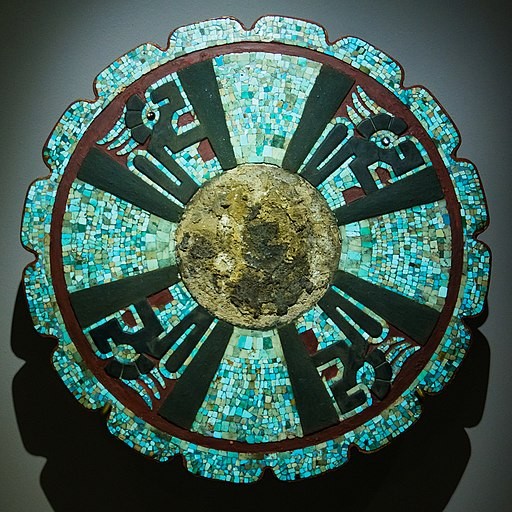
Ancient Maya built sophisticated water filters
Clean drinking water helped Tikal flourish, UC archaeologists say
Ancient Maya in the once-bustling city of Tikal built sophisticated water filters using natural materials they imported from miles away, according to the University of Cincinnati.
UC researchers discovered evidence of a filter system at the Corriental reservoir, an important source of drinking water for the ancient Maya in what is now northern Guatemala.

UC professor Kenneth Tankersley. Photo/Provided
A multidisciplinary team of UC anthropologists, geographers and biologists identified crystalline quartz and zeolite imported miles from the city. The quartz found in the coarse sand along with zeolite, a crystalline compound consisting of silicon and aluminum, create a natural molecular sieve. Both minerals are used in modern water filtration.
The filters would have removed harmful microbes, nitrogen-rich compounds, heavy metals such as mercury and other toxins from the water, said Kenneth Barnett Tankersley, associate professor of anthropology and lead author of the study.
“What’s interesting is this system would still be effective today and the Maya discovered it more than 2,000 years ago,” Tankersley said.
UC’s discovery was published in the journal Scientific Reports.
The project demonstrates UC's commitment to research as described in its strategic direction called Next Lives Here.

UC researchers Nicholas Dunning, left, Vernon Scarborough and David Lentz set up equipment to take sediment samples during their field research at Tikal. Photo/Liwy Grazioso Sierra
The Maya created this water filtration system nearly 2,000 years before similar systems were used in Europe, making it one of the oldest water treatment systems of its kind in the world, Tankersley said.
Researchers from UC’s College of Arts and Sciences traced the zeolite and quartz to steep ridges around the Bajo de Azúcar about 18 miles northeast of Tikal. They used X-ray diffraction analysis to identify zeolite and crystalline quartz in the reservoir sediments.
At Tikal, zeolite was found exclusively in the Corriental reservoir.
For the ancient Maya, finding ways to collect and store clean water was of critical importance. Tikal and other Maya cities were built atop porous limestone that made ready access to drinking water difficult to obtain for much of the year during seasonal droughts.
This is what you have to do as an archaeologist. You have to put together a puzzle with some of the pieces missing.
David Lentz, UC professor of biological sciences
UC geography professor and co-author Nicholas Dunning, who has studied ancient civilizations most of his career, found a likely source of the quartz and zeolite about 10 years ago while conducting fieldwork in Guatemala.
“It was an exposed, weathered volcanic tuff of quartz grains and zeolite. It was bleeding water at a good rate,” he said. “Workers refilled their water bottles with it. It was locally famous for how clean and sweet the water was.”
Dunning took samples of the material. UC researchers later determined the quartz and zeolite closely matched the minerals found at Tikal.

The ancient Maya city of Tikal flourished between the fifth and ninth centuries before the city eventually was abandoned. Photo/Jimmy Baum/Wikimedia Commons
UC assistant research professor Christopher Carr, an expert in geographic information system mapping, also conducted work on the UC projects at Bajo de Azúcar and Corriental.
“It was probably through very clever empirical observation that the ancient Maya saw this particular material was associated with clean water and made some effort to carry it back,” Dunning said.
“They had settling tanks where the water would be flowing toward the reservoir before entering the reservoir. The water probably looked cleaner and probably tasted better, too,” he said.
In a related paper published earlier this year in Scientific Reports, UC’s research team found that some reservoirs in Tikal eventually became polluted with toxic levels of mercury, possibly from a pigment called cinnabar the Maya used on plaster walls and in ceremonial burials. Corriental remained free of these contaminants.
UC anthropology professor emeritus Vernon Scarborough, another co-author, said most research on ancient water management has tried to explain how civilizations conserved, collected or diverted water.
“The quality of water put to potable ends has remained difficult to address,” Scarborough said. “This study by our UC team has opened the research agenda by way of identifying the quality of a water source and how that might have been established and maintained.”

UC geography professor Nicholas Dunning has spent his career studying ancient civilizations. The COVID-19 pandemic in 2020 marked only the second year in his professional life that he could not conduct fieldwork. Photo/Joseph Fuqua II/UC Creative + Brand
Of course, reconstructing the lives, habits and motivations of a civilization 1,000 years ago is tricky.
“We don’t have absolute proof, but we have strong circumstantial evidence,” Dunning said. “Our explanation makes logical sense.”
“This is what you have to do as an archaeologist,” UC biologist and co-author David Lentz said. “You have to put together a puzzle with some of the pieces missing.”
Lentz said the filtration system would have protected the ancient Maya from harmful cyanobacteria and other toxins that might otherwise have made people who drank from the reservoir sick.
“The ancient Maya figured out that this material produced pools of clear water,” he said.
Complex water filtration systems have been observed in other ancient civilizations from Greece to Egypt to South Asia, but this is the first observed in the ancient New World, Tankersley said.
“The ancient Maya lived in a tropical environment and had to be innovators. This is a remarkable innovation,” Tankersley said. “A lot of people look at Native Americans in the Western Hemisphere as not having the same engineering or technological muscle of places like Greece, Rome, India or China. But when it comes to water management, the Maya were millennia ahead.”
Tankersley said the next question he would like to answer is how widespread these filtration systems might have been across the ancient Mayan civilization. UC’s team is also studying how the ancient Maya prevented erosion from harming their prized reservoirs.
Featured image at top: A temple rises above the rainforest at the ancient Maya city of Tikal. Photo/David Lentz
More UC insights about ancient Maya

Ancient Mayan artwork from Mexico. Photo/CC Jebulon/Wikimedia Commons
- Smithsonian: UC finds pollution in ancient Maya city
- Research shows clearing rainforests caused climate change
- Legends of the lost reservoirs
- UC finds ancient Maya reservoirs contained toxic pollution
- UC researchers find ancient Maya farms in Mexican wetlands
- Evidence of ancient Maya farms points to complex economy
- UC research reveals water management and climate change in ancient Maya city
Impact Lives Here
The University of Cincinnati is leading public urban universities into a new era of innovation and impact. Our faculty, staff and students are saving lives, changing outcomes and bending the future in our city's direction. Next Lives Here.
Stay up on all UC's COVID-19 stories, read more #UCtheGood content, or take a UC virtual visit and begin picturing yourself at an institution that inspires incredible stories.
Related Stories
First-ever Gen-Z Insights event hosted by UC NEXT Innovation...
April 19, 2024
In academia, the intersection of innovation, collaboration and the fresh perspectives of the University of Cincinnati NEXT Innovation Scholars (NIS) holds immense promise. As a multi-disciplinary student group of innovators, the program balances university, corporate and non-profit partners. NIS students are driven by curiosity, passion, future creation and pursuing innovation, fostering a community of forward-thinkers poised to tackle tomorrow's challenges today. Recently, these young visionaries hosted an inaugural Gen-Z Insights showcase event at the UC 1819 Innovation Hub. The packed room of attendees included 1819 corporate partners such as Kao and Main Street Ventures and distinguished faculty and staff members. All were eager to hear and learn more from NIS scholars and the industry projects they worked on throughout the year.
UC offers experiential learning abroad in Central America
April 19, 2024
In the tropical paradise of Costa Rica, fourth year journalism and international affairs student Stephanie Rivera embarked on an unforgettable journey of self-discovery and cultural immersion. Leaving behind the familiar sights and sounds of Cincinnati, Rivera set out to study abroad for a transformative semester in this Central American country, rich with vibrant biodiversity and cultural heritage. The College of Arts & Sciences (A&S) at UC places great emphasis on encouraging study abroad and experiential learning opportunities for its students. Recognizing the transformative power of global experiences, the college supports a variety of study-abroad programs that enable students to enhance their academic pursuits while gaining valuable cultural and personal experiences.
UC's CECH recognizes students, faculty and staff for outstanding...
April 19, 2024
In the early weeks of April 2024, UC's College of Education, Criminal Justice, Human Services, and Information Technology recognized and celebrated students, faculty and staff achievements annual Outstanding Student Awards and All College Awards ceremony, the latter of which awarded both Faculty and Staff Awards and the college's Golden Apple Awards.
